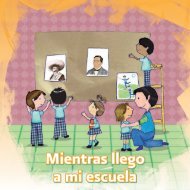Spanish for K-8 Heritage Speakers: A Standards-Based Curriculum ...
Spanish for K-8 Heritage Speakers: A Standards-Based Curriculum ...
Spanish for K-8 Heritage Speakers: A Standards-Based Curriculum ...
Create successful ePaper yourself
Turn your PDF publications into a flip-book with our unique Google optimized e-Paper software.
30 Hispania<br />
91 March 2008<br />
prises four areas that correspond with the WIDA <strong>Spanish</strong> language-arts standards (2006): 1)<br />
Language Structure and Use, 2) Writing, 3) Reading and Literature, and 4) Oral Language. As<br />
students develop and revisit skills and concepts throughout each scenario and grade, a clear<br />
spiral is evident. In each of the primary grades, children are <strong>for</strong>ming and building upon a founda<br />
tion of <strong>Spanish</strong> literacy by developing and practicing many of the same habits, concepts and<br />
skills, all in different ways and through varied contexts. In addition to content and skill spirals<br />
within each grade, there is also vertical spiraling among all grades. For example, the skills of<br />
making inferences and analyzing texts and messages are learned, practiced and revisited<br />
throughout the curriculum in challenging and authentic ways and at developmentally<br />
appropriate levels. The result of layering these two scopes and sequences creates a distinctive<br />
texture which students are empowered to use as they explore language and investigate the rich<br />
and diverse cultures of the <strong>Spanish</strong>-speaking world.<br />
Now, moving from the level of the linguistic and thematic scope and sequence documents,<br />
the next level of detail is the basic unit of the curriculum: the learning scenario. Because lesson<br />
plans are most effective and alive when left in the capable hands of creative teachers who have a<br />
keen ear to the heartbeat of their community of learners, we chose to use the narrative scenario as<br />
the vehicle <strong>for</strong> the curriculum. In the nascent stages of the project,<br />
we studied a range of curricula<br />
and read and discussed extensively various ways in which we could interweave the acquisition<br />
of <strong>Spanish</strong> language-arts skills and concepts through the study and analysis of culture. We<br />
envisioned something both accessible and dynamic <strong>for</strong> teachers, a curriculum that would<br />
empower teachers and students to add their unique voices to the learning process. Spinelli and<br />
Grundstrom Nerenz (2004) introduced us to the concept of a learning scenario. This immediately<br />
resonated with our vision: a practical and effective vehicle through which we could move "away<br />
from learning about language and toward learning to use language in culturally appropriate<br />
ways" (1). "Extended thematic units" was a phrase with which we all identified. Our ideas and<br />
discussions around the authentic use of <strong>Spanish</strong>, generating and using language in order to<br />
discover and explore, to know and understand, to agree and disagree, to deepen one's under<br />
standing of oneself, of one's community and of one's place in the world, all coalesced in our<br />
interpretation of the learning scenario. Consequently, scenarios are not lesson plans. They are<br />
similar to thematic language-arts units of study that need to be unpacked by teachers and<br />
brought to life through collaborative communities using language in multiple and authentic<br />
ways.<br />
There are three examples of learning scenarios from this curriculum in the Appendix. Two<br />
things appear at the beginning of each scenario: the WIDA <strong>Spanish</strong> Language-Arts standards<br />
met by that scenario, and the learning objective of the scenario. Occasionally, additional <strong>Spanish</strong><br />
Language-Arts objectives that we felt were addressed by the scenario are added to the WIDA<br />
standards. As explained in a previous section, the WIDA standards outline what the students<br />
will be developing, applying and revisiting. The scenario objective provides a brief synopsis of<br />
how the objectives will be met.<br />
Initially, each scenario was constructed around <strong>Spanish</strong> language arts objectives that were<br />
clearly developed and applied through the exploration of cultures of the <strong>Spanish</strong>-speaking world.<br />
As we began writing, however, we realized we needed to revisit various resources we had initially<br />
studied in order to embed the cultural elements in ways that would generate sincere reflection and<br />
dialogue about culture. With this in mind, we revisited Volumes III and IV of the AATSP hand<br />
book series (2001). In particular, the chapter by Galloway (2001) armed us with clear goals<br />
regarding the integration of culture and language arts. We set language flexibility as a priority.<br />
The shifting of registers according to contexts, <strong>for</strong> example,<br />
was clearly a significant skill, but<br />
Bennett's model pushed us to consider ways in which our curriculum could aspire to cultivate an<br />
ability to reflect on language use and the inherent power of language. We understood that this<br />
could only be achieved when one is fully integrated into a language and into a culture. Although<br />
true cultural integration would most likely not happen in the classroom, we set cultural integra<br />
tion as an ideal <strong>for</strong> our scenarios.



